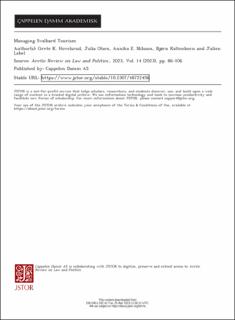Managing Svalbard Tourism: Inconsistencies and Conflicts of Interest
Peer reviewed, Journal article
Published version

Åpne
Permanent lenke
https://hdl.handle.net/11250/3066698Utgivelsesdato
2023Metadata
Vis full innførselSamlinger
- Publikasjoner fra CRIStin - NINA [2364]
- Scientific publications [1392]
Sammendrag
The Svalbard Archipelago has experienced a rapid increase in tourism-related activities over the past few decades. The Norwegian Government’s ambition to develop the Archipelago’s tourism industry offers multiple socio-economic opportunities. The development and scope of these tourism activities is affected by a complex governance system that entails strict environmental regulation and preparedness considerations. To understand the balance of goals across the national and international policy levels, we have mapped, reviewed, and analyzed the national and international regulations and agreements that affect tourism activities on Svalbard. The document analysis reveals the framework of natural and environmental consideration, access to areas and passage, requirements for organized outdoor activities, and regulatory tools. We discovered conflicts and internal inconsistencies in the way that Svalbard tourism has developed. It has been shaped by both economic growth and environmental preservation, without any specific business development objectives and goals or acceptable limits of environmental and social change in place. For tourism stakeholders, this might complicate any rational assessment of the balance between economic development and environmental status. The challenges we have identified are specific to Svalbard, but are likely to be similar in many other Arctic locations involved in tourism. Svalbard, regulations, environment, sustainability, tourism, cruise, governance, Arctic
